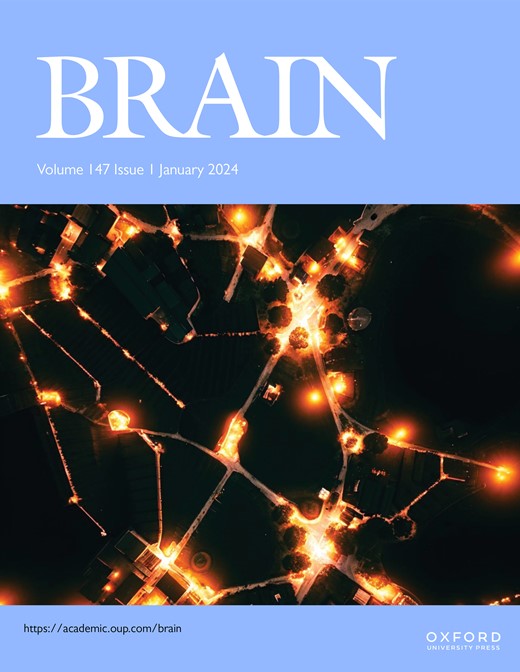脑卒中后神经递质信息连接图及其在预后推断中的应用。
IF 10.6
1区 医学
Q1 CLINICAL NEUROLOGY
引用次数: 0
摘要
神经科学是通过将许多神经精神疾病定义为网络疾病而发展起来的。神经递质(NT)系统的改变是这些疾病发展的核心。最近,来自PET示踪数据的全脑NT指纹的规范数据已经可以访问;与中风后遗症相关的数据有限。本研究旨在探索(1)NT数据与全脑结构连通性分析的整合;(2)其对理解脑卒中后预后变异性的潜在贡献。将NT受体和转运体密度的规范图谱与规范结构连接组相结合,生成5 -羟色胺、多巴胺、GABA、谷氨酸和乙酰胆碱受体和转运体的NT特异性连接图谱。卒中病变数据来自两个独立的、匹配的队列,共包括126名严重受损的急性卒中患者,用于评估每个受体和转运体分布的患者特异性nt相关网络损伤。多变量逻辑回归模型应用于评估脑卒中后3至6个月nt信息网络断开与功能结果之间的关系,通过修改的Rankin量表(mRS)进行操作。根据病变引起的全局网络损伤、年龄、性别、病变体积和基线神经症状负担对分析进行调整。我们提出了一种创新的方法,将各种NT系统的PET示踪数据纳入规范的结构连接体数据。由此产生的nt信息连接图显示了与已有文献一致的独特空间分布。在两组严重受损的卒中患者中,在特定的NT系统中合并病变引起的中断比单独的结构断开提供了更多关于卒中结局变异性的见解。值得注意的是,多巴胺转运体(DAT)密度高的神经网络损伤越大,功能恢复越差。基于具有不同地形特征的单个受体和转运体的nt信息结构连接图,我们表明,除了全球结构网络损伤之外,损伤诱导的大规模多巴胺能脑网络中断可能在中风恢复中发挥关键作用。这些见解具有重大的转化潜力,可以推进中风护理中的个性化医疗,例如通过靶向药物干预实现的个性化医疗。本文章由计算机程序翻译,如有差异,请以英文原文为准。
Neurotransmitter-informed connectivity maps and their application for outcome inference after stroke.
Neuroscience has evolved by framing numerous neuropsychiatric conditions as network diseases. Alterations within neurotransmitter (NT) systems are central to the development of these diseases. Recently, normative data on whole-brain NT fingerprints derived from PET tracer data has become accessible; limited data related such information to sequelae after stroke. This work aims to explore (1) the integration of NT data into whole-brain structural connectivity analyses and (2) its potential contribution to understanding outcome variability following stroke. Normative maps of NT receptor and transporter densities were integrated with a normative structural connectome to generate NT-specific connectivity maps for serotonin, dopamine, GABA, glutamate, and acetylcholine receptors and transporters. Stroke lesion data from two independent, matched cohorts comprising a total of 126 severely impaired acute stroke patients were used to assess NT-related network damage on a patient-specific basis across each receptor and transporter distribution. Multivariable logistic regression models were applied to evaluate the relationship between NT-informed network disconnections and functional outcomes three to six months post-stroke, operationalised by the modified Rankin scale (mRS). Analyses were adjusted for lesion-induced global network damage, age, sex, lesion volume, and baseline neurological symptom burden. We present an innovative method to incorporate PET tracer data of various NT systems into normative structural connectome data. The resulting NT-informed connectivity maps revealed distinct spatial distributions consistent with the established literature. In both cohorts of severely impaired stroke patients, incorporating lesion-induced disruptions within specific NT systems provided more insights into variability in stroke outcomes than structural disconnection alone. Notably, greater damage to networks with high dopamine transporter (DAT) density was associated with poorer functional recovery. Based on NT-informed structural connectivity maps with distinct topographical features for individual receptors and transporters, we show that lesion-induced disruptions in large-scale dopaminergic brain networks, beyond global structural network damage, may play a key role in stroke recovery. These insights hold significant translational potential for advancing personalised medicine in stroke care, such as those achieved by targeted pharmacologic interventions.
求助全文
通过发布文献求助,成功后即可免费获取论文全文。
去求助
来源期刊

Brain
医学-临床神经学
CiteScore
20.30
自引率
4.10%
发文量
458
审稿时长
3-6 weeks
期刊介绍:
Brain, a journal focused on clinical neurology and translational neuroscience, has been publishing landmark papers since 1878. The journal aims to expand its scope by including studies that shed light on disease mechanisms and conducting innovative clinical trials for brain disorders. With a wide range of topics covered, the Editorial Board represents the international readership and diverse coverage of the journal. Accepted articles are promptly posted online, typically within a few weeks of acceptance. As of 2022, Brain holds an impressive impact factor of 14.5, according to the Journal Citation Reports.
 求助内容:
求助内容: 应助结果提醒方式:
应助结果提醒方式:


